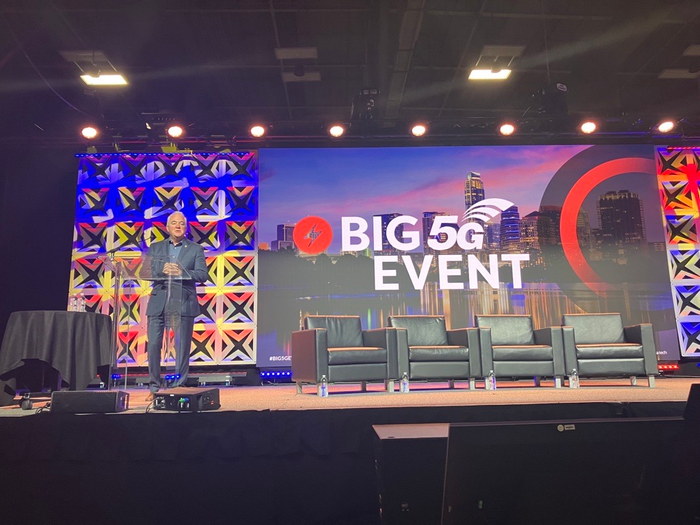At the Big 5G event in Austin, many speakers addressed the issue of sustainability, speaking of improving energy efficiency and ensuring 6G has environmental KPIs built into it.

AUSTIN – Big 5G Event – Sustainability has become an important issue for the telecom sector, with topics like emissions and waste reduction coming up frequently. But it is important to establish unified ways to set and measure targets and to make sure they are being upheld.
Bhushan Joshi, head of sustainability and corporate responsibility at Ericsson, who chairs NGA's Green G working group, spoke of the importance of establishing KPIs that will make 6G sustainable by design.
The pressure is on, with Joshi pointing out that as extreme weather events are becoming more commonplace, societies as well as investors are increasingly aware of the risks presented by climate change. Inside the ICT industry, meanwhile, there is a focus on energy efficiency to reduce power costs, which make up a big part of opex.
Figure 1:  Verizon's James Gowen speaking during the Big 5G event.
Verizon's James Gowen speaking during the Big 5G event.
(Source: Tereza Krásová/Light Reading)
This resonates with remarks made by James Gowen, senior vice president, sourcing, global supply chain, and chief sustainability officer at Verizon. During his keynote at the Big 5G Event, he noted the company was investing heavily in renewable energy, among other environmental initiatives, and said there was great appetite on Wall Street for sustainable investments.
Last week, he said, Verizon issued its fifth green bond worth $1 billion. Verizon has told Light Reading that the latest green bond was oversold by about six times. Gowen went on to say: "Take those $5 billion dollars, $4 billion has already been spent, the fifth one came last week," adding he believed this may well be spent within a year.
Moving from energy efficiency to net zero
In the meantime, the Green G working group is looking further to the future, assessing how to reduce 6G's environmental footprint and energy consumption. A part of this is looking at how sustainability KPIs can be effectively measured across the industry. The goal is to embed sustainability into 6G from the very start, integrating it in research, standardization, design, production and operation.
If 5G was about energy efficiency, Joshi said, then 6G needs to be about net zero. So far, the working group has released two white papers. The first one – from 2022 – created a high-level overview of the climate change challenge, while the second one from this year includes high-level KPIs, establishing what KPIs currently exist and what gaps there are in order to target research.
Next, the plan is to produce a series of white papers that will go deeper into different components such as the radio access networks (RAN) and the cloud.
During a subsequent panel, the conversation turned to how the industry can put such KPIs in place and adhere to them. Joshi expressed the view that in this case, the sector tends to move faster than regulation.
Rajendra Sadhu of Innova Solutions noted sustainability may be integrated in existing testing procedures that companies already have to comply with. He said this is the only way to make sure everyone is complying with KPIs. Sarah LaSelva, director of 6G marketing at Keysight Technologies, meanwhile pointed to standardization and 3GPP involvement as a way to embed sustainability in the ICT sector.
At the same time, it is important to make note of the impact the sector can have on decarbonization in other sectors. Joshi said that telecom can save 15% of emissions in high-emitting sectors, meaning there is potential to have an impact in areas other than the telecom industry.
The consensus seemed to be that while the industry has already done a lot to increase its energy efficiency, there is still more to be done. LaSelva noted that while 5G is performing very well in this area, few basestations are dedicated to this generation alone, with MIMO antennas placed on top of older equipment, adding to energy consumption.
This, again, resonates with Gowen's remark made during his keynote, when he pointed to legacy equipment in the network as often having poor energy efficiency.
Apart from deploying more efficient equipment, Joshi pointed out there should also be focus on integrating sleep modes into the network. Machine learning, he said, could be used "to orchestrate when things are turned off based on traffic."
There is concern, however, that energy saved by AI and machine learning may be less than that consumed during the training of those technologies. That has yet to be determined, said LaSelva.
Update: This story has been updated since it was published to reflect that Verizon issued its latest green bond last week, not last year. A quote saying all five green bonds have been oversold by about six times was also removed after Verizon contacted Light Reading to clarify only the last green bond was oversubscribed.
Related posts:
— Tereza Krásová, Associate Editor, Light Reading
About the Author(s)
You May Also Like











